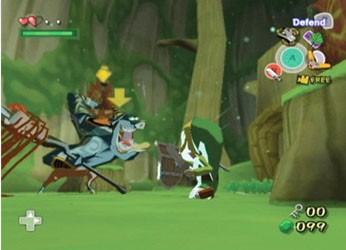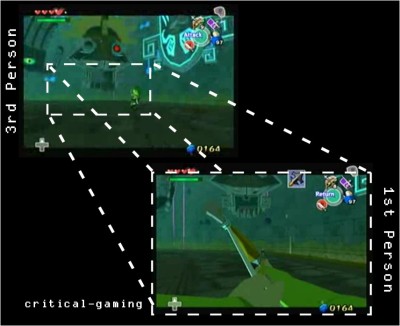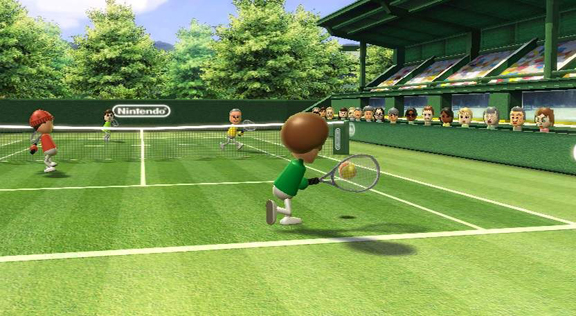2D + 2D = 3D pt.5
 Tuesday, March 3, 2009 at 9:03AM
Tuesday, March 3, 2009 at 9:03AM Part 1. Part 2. Part 3. Part 4.
Navigating, interacting, and interpreting 3D space is too difficult for the average gamer. When Mario 64 came out, we all had to learn that perspective is a key factor with 3D games. To play this 3D platformer well, players had to master Mario's moves as well as the camera control. Not only does the camera provide the game view, but the camera position also affects the player's controls. To experience this effect first hand, try moving Mario in a straight line toward any target while constantly spinning the camera around. If you do this, you'll quickly understand that to keep Mario moving straight, you have to compensate by rotating the analog stick in the opposite direction of the camera rotation and at the same rate.
Mario's movement controls have always been relative to how we view the game world. In Super Mario Brothers, a 2D side-scrolling platformer, holding right always moved Mario to the right and toward the end of the level. In a 3D game, how we view the gameworld changes relativity of the controls. Understanding the relationship between the camera perspective and the controls requires constantly triangulating the positions between the Mario (the player avatar), the target, and the camera position. Such calculations are more than most people are willing to actively do. Fortunately, most gamers have naturally developed a few tricks that simplify the 3D space and 3D triangulations.

I've watched many people play Super Mario 64. When up against tricky platforming challenges, the gamers that weren't comfortable triangulating the game space used an interesting technique. By moving the camera so that the perspective lines up directly behind Mario, players essentially change the 3D perspective challenge, into a 2D challenge. Now the player only has to focus on moving forward and JUMPing at the right time. In other words, the 3 points/factors that make up the triangulation can be manipulated into 2D line, which is a much simpler geometric shape.
Simplifying 3D doesn't just happen in 3D platformers. All 3D games with a player controlled camera system have the potential to simplify or clutter the fidelity of the game perspective. To help us out, developers have designed mechanics that help to simplify 3D gameplay.
Simplifying 3D
Super Mario 64 showed the world how 3D spaces, mechanics, and cameras can be designed to take advantage of they dynamics of 3D space. Unlike the 2D Mario platformers that came before it, the enemy design and influence in Mario 64 is very minimal. With such a volume of space to platform in, enemies are much more infrequent, must less effective, and no longer a critical element in what makes the game's challenges challenging. Now that players have 8 health points, Mario can take several hits before dying. And if a player is ever low on health, a few coins or some water can restore Mario's health. Mario 64 isn't designed around combat.
It wasn't until The Legend of Zelda: Ocarina of Time (OOT) that 3D combat was revolutionzied. Just like with their 2D games, the difference between Mario and Zelda's enemies are great. In OOT, enemies are designed with greater degree of complexity. They will seek you out using pathfinding, strafe around you, go on the attack, switch to defense, run away from you, wait for you to get close, shoot you at range, etc. Zelda enemies can exist at any point in 3D space around Link. Enemies in Zelda can swim in the water at your feet, fight you on the ground, hover just above the ground, or fly around high into the air. When fighting these enemies OOT gives players a range of perspective changing design techniques/mechanics that increasingly simplify the 3D gameplay into 2D gameplay. The first design feature I want to cover is functionally equivalent to when players line up the camera in Super Mario 64 to make difficult jumps.
Lock-on Mechanics & Relative Space
 I know the discussion is on OOT, but this image is just too awesome.
I know the discussion is on OOT, but this image is just too awesome.
By holding the Z button on the N64 controller, players are able to lock the camera view behind Link and a pointed squarely on a target. If Link moves when locked on, the camera stays behind him. If the target moves, the camera swivels to stay focused on it. When locked-on, forward and back movement is relative to the target. At the same time, side to side movement is also relative causing Link to circle strafe around the target.
Along with the focused perspective and altered movement capabilities, the lock-on mechanic also uses pathfinding or auto-aim to point all of the player's attacks at the target. Whether the player uses sword strikes or projectiles, they are always automatically aimed at the target. This is significant because of how a 2D plane of relative space is created between the player and the target. With either grounded or flying enemies, when the aim is auto adjusted in this way, the necessity to triangulate between the avatar, target, and camera is eliminated. Locking on creates a functional line of intent between the player and the target. With only 2 points/factors to consider (avatar vs. target) the 3D space the factors take up is simplified to a 2D relationship.
Other games that use lock-on mechanics are DMC4, Ninja Gaiden Sigma, and all of the 3D Zelda games. Games like Katamari Damacy and Super Monkey Ball feature a camera system that is locked behind the player avatar's back. This design helps simplify the perspective of the game and the camera control. Taking the concept of combined player and camera controls, there is a type of 3D perspective that offers freedom of movement, freedom of aim, and a fixed perspective. For these reasons this perspective greatly simplifies 3D gameplay, which is probably the reason why it is so popular today.
The First Person Perspective
 You can watch the boss fight here.
You can watch the boss fight here.
The first person perspective shows a game world through the eyes of the player avatar. In games that give the player camera/view control, the player is put in control of viewing the game world. Compared to the 2D perspectives and 3rd person perspectives, the FP perspective is the most limiting game view (see image above). Players are limited to a narrow cone of vision that displays much less than what is contained inside the average human vision range. For these reasons, the player must actively look around to understand the world around him/her. In this way, understanding the 3D world is a core dynamic.

With first person shooters, looking and aiming are one. When holding a gun, everything you see is set along the sights of the firearm. With dual analog, keyboard and mouse, or Wiimote + Nunchuck controls, aiming/looking is essentially 2D. Because guns are such accurate and powerful weapons, when firing bullet like projectiles the 3D space between the gun barrel and the target is compressed and almost entirely minimized. In other words, when you pull the trigger, if the target is in your sights it's a hit. If the target is not, it's a miss. In this way, FPS aiming and shooting is functionally 2D.
Many people think that FPSs are fairly simple. The left stick controls the character movement like a top down game. The right stick controls the aim and perspective in 2D. To hit targets, one needs to only align the reticle and push a button. Combining these two systems allows for players to move through 3D space, but at the same time simplify 3D space by compressing it into functionally 2D space.
From Super Mario Galaxy to Halo 3, understanding 3D gameplay games consist of understanding the mechanics, perspective, and how the 2D inputs from the game controllers translate into the 3D space. Now, with the Wiimote, the Sixaxis, and even the Novint Falcon games can finally let players control 3D mechanics using 3D inputs.
3D Mechanics/Input/Interaction
The Wiimote is to 3D control, as the touch screen is writing/drawing controls. Sure, with a lot of practice you can become quite a competent artist using a D-pad. But writing or drawing in this way isn't isn't as intuitive or as versatile as using a touch screen. In the same way, nothing can be more intuitive for a 3D mechanic/interaction than a 3D input.

Take Wii Sports Tennis for example. With one motion of the Wiimote, I can put a variable amount of spin on the ball, hit it toward a specific side of the court, launch it a specific distance upward, and drive it with a specific amount of force forward. In other words, I can control the power, direction, and spin of the ball all in one intuitive motion. If Wii Sports Tennis were designed around a more traditional controller, there would probably be separate buttons for the lob, slice, and top spin shots in addition to the ability to hold down each button for increased power. The Wiimote Wii Sports Tennis design simplifies the controls by removing buttons and making the motions intuitive while keeping the directness of the mechanics very high. All of the Wii Sports games are designed with this level of 3D intuitive and direct mechanics.

Excite Truck: In this game players can land their trucks from the air on all four tires for a speed boost. Because the terrain is so uneven, bumpy, and hilly, landing on all tires requires the player to angle the truck beforehand in mid air. Controlling the truck is as simple as tilting the Wiimote as if it were the handle bars of your truck. Turning and tiling the truck in mid air engages all 3 dimensions, making the air control mechanic a 3D controlled mechanic in a full 3D gameplay game.
These 3D motion controls also create a new kind of perspective that's based on how you play the game as opposed to how the camera displays the game world. The direction Mario moves when pushing the analog stick in one direction is dependant on the camera position. But no matter how the camera is positioned in Wii Sports Tennis, swinging the Wiimote the same way will always produce the same effect because of how the motion controls are intuitively designed to mimic real life tennis swings.
We have come to the end of a long and detailed look at 2D and 3D dynamics and game design. Hopefully, now you understand that 3D space is little more than an added dimension that changes everything in the world of game design. So many have made 3D games, and so many have missed the mark in one way or another. It's not surprising that the Mario and Zelda games provided such excellent examples for side-scrolling, top down, and 3D game design. After experiencing Super Mario Galaxy and The Legend of Zelda: Twilight Princess, two games in two long running series of 3D space and game design innovators, I know that video games are capable of even greater levels of design.
Perhaps the next step for 3D gaming is head tracking.
 Halo,
Halo,  Wii Sports,
Wii Sports,  Zelda in
Zelda in  Abstraction,
Abstraction,  Controller Design,
Controller Design,  Dynamics |
Dynamics |  Permalink |
Permalink |  Print Article
Print Article 
